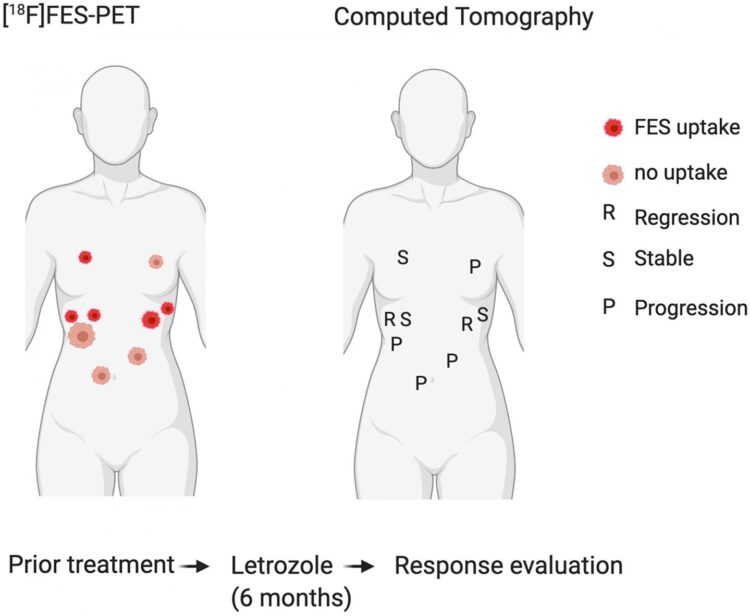Granulosa cell tumors are a well-defined ovarian cancer subtype, responsible for 2-5% of ovarian malignancies with an annual incidence of 0.6-1.0 per 100.000 women worldwide
Oncotarget published “[18F]FDG and [18F]FES positron emission tomography for disease monitoring and assessment of anti-hormonal treatment eligibility in granulosa cell tumors of the ovary” which reported that the authors evaluated 22 PET/CTs from recurrent Anti-hormonal granulosa cell tumors (AGCT) patients to determine tumor FDG and FES uptake by qualitative and quantitative analysis.
They included all consecutive patients from two tertiary hospitals between 2003-2020.
Expression of ERα and ERβ and mitoses per 2 mm2 were determined by immunohistochemistry and compared to FES and FDG uptake, respectively.
Qualitative assessment showed low-to-moderate FDG uptake in most patients, and intense uptake in 2/16. One patient with intense tumor FDG uptake had a high mitotic rate two out of six patients showed FES uptake on PET/CT at qualitative analysis.
Within patients, expression of ERα and ERβ varied and did not seem to correspond with FES uptake.
In one FES positive patient, tumor locations with FES uptake remained stable or decreased in size during anti-hormonal treatment, while all FES negative locations progressed.
Dr. Joline F. Roze from The Utrecht University said, “Granulosa cell tumors are a well-defined ovarian cancer subtype, responsible for 2-5% of ovarian malignancies with an annual incidence of 0.6–1.0 per 100.000 women worldwide.“
Granulosa cell tumors are a well-defined ovarian cancer subtype, responsible for 2-5% of ovarian malignancies with an annual incidence of 0.6–1.0 per 100.000 women worldwide.
Surgery is the mainstay of treatment throughout the disease course, due to generally limited effects of systemic treatments such as chemotherapy and hormone therapy.
These studies found no FDG uptake in two patients, moderate uptake in two patients and intense FDG uptake in one patient with a bone metastasis.
A previous study showed that anti-estrogen treatment can decrease tumor load in a subset of 22 AGCT patients.
Nevertheless, it remains difficult to determine the treatment of choice and to identify patients that may benefit from this treatment.
This study investigates the value of FDG-PET/CT for disease monitoring and FES-PET/CT for indicating anti-hormonal treatment eligibility in AGCT patients.
The Roze Research Team concluded in their Oncotarget Research Output that it remains a clinical challenge to establish the optimal timing of treatment for AGCT recurrences.
Besides PET-CT, other diagnostics such as detection of circulating tumor DNA in plasma, are currently being investigated for disease monitoring and estimation of disease activity.
Given the low incidence of this disease, performing prospective trials in AGCT is difficult.
Future prospective research on FES-PET/CT could elucidate whether this imaging tool can be used to predict the response to hormonal treatment in AGCT patients.
###
DOI – https:/
Full text – https:/
Correspondence to – Joline F. Roze – [email protected]
Keywords –
positron emission tomography (PET),
18F-fluoroestradiol (18F-FES),
18F-fluoro-deoxyglucose (18F-FDG),
granulosa cell tumors (GCTs),
hormone receptors
About Oncotarget
Oncotarget is a bi-weekly, peer-reviewed, open access biomedical journal covering research on all aspects of oncology.
To learn more about Oncotarget, please visit https:/
SoundCloud – https:/
Facebook – https:/
Twitter – https:/
LinkedIn – https:/
Pinterest – https:/
Reddit – https:/
Oncotarget is published by Impact Journals, LLC please visit https:/
Media Contact
[email protected]
18009220957×105
Impact Journals is a registered trademark of Impact Journals, LLC
Media Contact
Ryan James Jessup
[email protected]
Original Source
https:/
Related Journal Article
http://dx.





